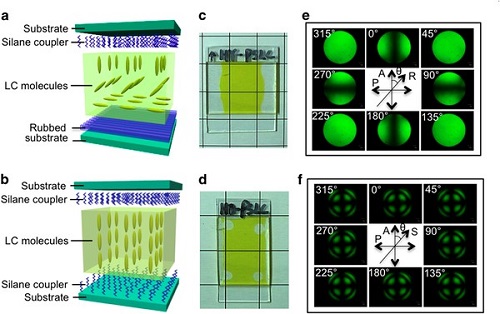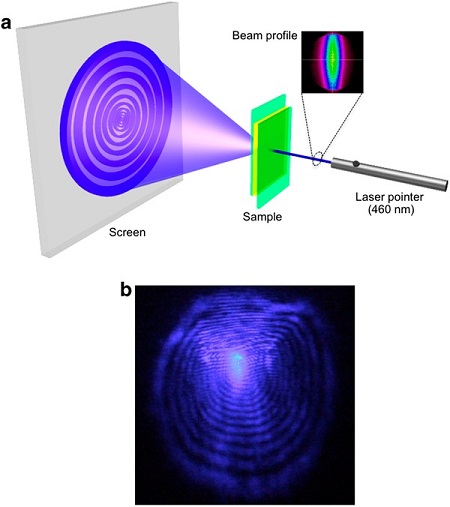最新の研究
- 2015.07.08
光の強さを認識して応答する材料
〜光応答液晶の分子配向〜
液晶はディスプレイとして広く知られるが,専門用語としては光学異方性と流動性を兼ね備えた物質もしくは状態として定義される。簡単に言えば,液体と結晶の中間の性質を示す。液晶の特徴の一つに優れた外場応答性がある。分子の配向が印加電界に応じ容易に変化することを利用してディスプレイ材料に用いられている訳である。ただし,適切な分子の選択と材料設計によっては,「光」という外部刺激に応答する液晶材料を創製することもできる。アゾベンゼンや桂皮酸などの光異性化反応や光二量化,すなわち光化学反応を利用した分子配向変化が一般的である。一方,光化学反応を利用しない光分子配向材料も構築されてきた。非線形光学効果を駆動原理としているため,分子配向変化に必要な光強度が極めて高い問題はあるが,強度依存性を有するため興味深い。1-15 光の強さを認識するスマートな材料へ応用できる可能性があるからである。最近われわれは,高分子安定化のコンセプトを色素ドープ液晶に導入することで,従来と比較して低い光強度で分子配向変化を誘起できる光強度認識型材料の創製に成功している。16-19
表面をシランカップリング処理したスライドガラスで厚さ100μmのセルを作製し,オリゴチオフェン誘導体・5CB・シアノビフェニルアクリレート・架橋剤の混合物を調製した。高圧水銀灯から取り出した波長366 nmの紫外光を室温で照射して光重合を行い,アニーリング処理を施しサンプルを得た(Fig.1)。作製したセルは透明で均一な分子配向を有することがわかった。偏光顕微鏡でコノスコープ像の観察を行ったところ,画像中央に暗い十字であるアイソジャイアが現れた。さらに,偏光UV-Vis スペクトル測定において水平方向と垂直方向の偏光を入射したスペクトルが完全に一致する事から,サンプル中の液晶分子は基板に垂直なホメオトロピック配向であることが明らかとなった。一方,基板の片側にラビング処理を施したセルでは,ハイブリッド配向と呼ばれる初期分子配向が誘起される。ハイブリット配向では,セルの深さに応じて基板に対して平行な分子配向から垂直な分子配向へと連続的な変化が起こる。
光配向挙動を調べるため透過レーザー光の観察を行った。初期分子配向が基板に垂直なホメオトロピック配向セルにガウシアン型の直線偏光を照射すると弱い光では配向変化は起こらず,ビームはそのままの形でサンプルを通過した。しかし,高強度の光を照射すると,スクリーン上に広がった回折光が現れた。この回折光のリング数は分子配向変化を評価する指標となる。光強度とこの回折リングの数の関係を観察することで分子配向の閾値を調べたところ,光強度3.4 W/cm2でリングが現れ,最大リング数は28に達した。さらに,ハイブリッド配向セルに光を入射したところ,分子配向に必要な光強度は0.4 W/cm2まで低減することが明らかとなった。

Figure 1. (a) Sketch of the geometry of a hybrid-aligned cell.
(b) Sketch of the geometry of a homeotropic-aligned cell.
(c) Photograph of a hybrid-aligned cell. (d) Photograph of a homeotropic-aligned cell. (e) Polarized optical micrograph of a hybrid-aligned cell on a rotatable stage. (f) Polarized optical micrograph of a homeotropic-aligned cell on a rotatable stage. Optically transparent film with hybrid alignment is confirmed from photograph and conoscopic images with a polarized optical microscope. 16
このハイブリッド配向セルにおけるリング形成に必要な光強度は過去の報告例と比較しても桁違いに低い。そこで,市販のレーザーポインター光を用いて実験したところ,同様の現象を観察できた(Fig.2)。今後さらなる光強度の低下により,住宅窓や調光サングラスなど従来の非線形光学効果では検討されなかったデバイスへの展開が期待される。

Figure 2. (a) Sketch of the optical setup for the observation of the laser-pointer-driven nonlinear optical effect in a hybrid-aligned cell. (b) Typical laser-pointer-driven ring pattern generated from a hybrid-aligned cell (TR5: 0.03 mol%). A 1 mW commercially available laser pointer drives molecular reorientation, leading to self-focusing and self-phase modulation.16
References
1 Shen, Y. R. The principles of nonlinear optics John Wiley & Sons: New York, 1984).
2 Tabiryan, N. V., Sukhov, A. V. & Zel'dovich, B. Y. The orientational optical nonlinearity of liquid crystals. Mol. Cryst. Liq. Cryst. 136, 1-139 (1986).
3 Dalton, L. R., Sullivan, P. A. & Bale, D. H. Electric field poled organic electro-optic materials: state of the art and future prospects. Chem. Rev. 110, 25-55 (2010).
4 Kumar, R. A. Borate crystals for nonlinear optical and laser applications: a review. J. Chem. 2013, 1-6 (2013).
5 Pawlicki, M., Collins, H. A., Denning, R. G. & Anderson, H. L. Two-photon absorption and design of two-photon dyes. Angew. Chem. Int. Ed. 48, 3244-3266 (2009).
6 Park, S., Yang, D. & Lee, K. Two-photon stereolithography for realizing ultraprecise tree-dimensional nano/microdevices. Laser Photon. Rev. 3, 1-11 (2009).
7 Peccianti, M. & Assanto, G. Nematicons. Phys. Rep. 516, 147-208 (2012).
8 Dudley, J. M., Genty, G. & Coen, S. Supercontinuum generation in photonic crystal fiber. Rev. Mod. Phys. 78, 1135-1184 (2006).
9 Sasaki, T., Mori, Y., Yoshimura, M., Yap, Y. K. & Kamimura, T. Recent development of nonlinear optical borate crystals: key materials for generation of visible and UV light. Mater. Sci. Eng. R. 30, 1-54 (2000).
10 Yesodha, S. K., Pillai, C. K. S. & Tsutsumi, N. Stable polymeric materials for nonlinear optics: a review based on azobenzene systems. Prog. Polym. Sci. 29, 45-74 (2004).
11 Khoo, I. C. Nonlinear optics of liquid crystalline materials. Phys. Rep. 471, 221-267 (2009).
12 Hrozhyk, U. A. et al. Azobenzene liquid crystalline materials for efficient optical switching with pulsed and/or continuous wave laser beams. Opt. Exp. 18, 8697-8704 (2010).
13 Matharu, A. S., Jeeva, S. & Ramanujam, P. S. Liquid crystals for holographic optical data storage. Chem. Soc. Rev. 36, 1868-1880 (2007).
14 Khoo, I. C. et al. Dye-doped photorefractive liquid crystals for dynamic and storage holographic grating formation and spatial light modulation. P. IEEE. 8, 1897-1911 (1999). Sio, L. D., Tabiryan, N., Bunning, T., Kimball, B. R. & Umeton, C. Dynamic photonic materials based on liquid crystals. Prog. Opt. 58, 1-64 (2013).
15 Matsumoto, S., Kawamoto, M. & Mizunoya, K. Field-induced deformation of hybrid-aligned nematic liquid crystals: New multicolor liquid crystal display. J. Appl. Phys. 47, 3842-3845 (1976).
16 Wang, J., Aihara, Y., Kinoshita, M., Mamiya, J., Priimagi, A., Shishido, A. Laser-pointer-induced self-focusing effect in hybrid-aligned dye-doped liquid crystals. Sci. Rep. 5, 9890 (2015).
17 Wang, J., Aihara, Y., Kinoshita, M., A., Shishido, A. Effect of polymer concentration on self-focusing effect in oligothiophene-doped polymer-stabilized liquid crystals. Opt. Mater. Exp. 5, 538-548 (2015).
18 Priimagi, A., Barrett, C. J. Shishido, A. Recent twists in photoactuation and photoalignment control. J. Mater. Chem. C 2, 7155-7162 (2014).
19 宍戸 厚,光分子配向法とフィルムの力学解析. 液晶, 19, 15-22 (2015).



